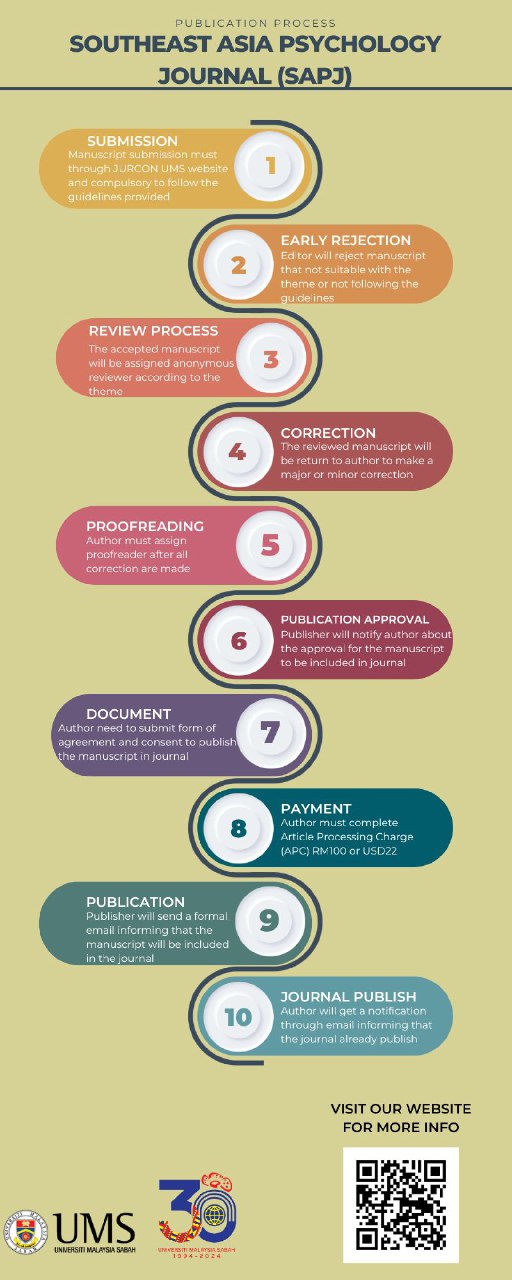SEBAB-SEBAB TINGKAH LAKU MENCEDERAKAN DIRI DALAM KALANGAN REMAJA DI BANDAR KOTA KINABALU
DOI:
https://doi.org/10.51200/sapj.v9i1.4957Keywords:
Reasons for Self-Harm, Adolescents, Kota Kinabalu CityAbstract
Self-harm behavior is a major problem that causes a person to commit suicide. However, the issue of self-harm behavior is an issue that is very rarely discussed by the community in Malaysia. Therefore, this study was conducted to find out the causes of self-harm among 720 adolescents involved in self-harm behavior in Kota Kinabalu City, Sabah. Self-Hurt Assessment was used as a research questionnaire to collect data. The results of the study found that the main reason adolescents harm themselves is "to feel relaxed" (intrapersonal). As many as 22.5% (162) of the adolescents stated that they always commit acts of self-harm because they want to feel relaxed. The second reason is "so that parents can understand me," (interpersonal) which is 17.9% (129) adolescents stated that they harm themselves because they want parents to understand them. While the third reason for harming oneself has two, namely "to do something while alone and" to be like someone I respect. " Both of these items are interpersonal factors, each comprising 12.5% with a total of 90 students. The findings of this study have implications for agencies that provide services to adolescents. These agencies can provide programs that teach adolescents how to channel emotions well because adolescents today are the pillars of the country of the future.
References
Ainsah, O., Norharlina, B. & Osman, C. B. (2008). The association between deliberate self-harm and menstrual cycle among patients admitted to Hospital Kuala Lumpur. Hong Kong Journal of Psychiatry, 18, 158-165.
Alfonso, M.L. (2007). The tip of the blade: Self-injury among early adolescents. (Unpublished doctoral dissertation). University of South Florida.
Baetens, I., Claes, L., Onghena, P., Grietens, H., Leeuwen, K. Van, Pieters, C., … Grif, J. W. (2014). Non-suicidal self-injury in adolescence: A longitudinal study of the relationship between NSSI, psychological distress and perceived parenting, 37, 817–826.
Burke, T. A., Hamilton, J. L., Abramson, L. Y., & Alloy, L. B. (2015). Non-suicidal self-injury prospectively predicts interpersonal stressful life events and depressive symptoms among adolescent girls. Psychiatry Research, 228(3), 416–424.
Cleaver, K. (2007). Adolescent nursing: Characteristics and trends of self-harming behavior in young people. British Journal of Nursing, 16(3), 148-153.
Cerutti, R., Manca, M., Presaghi, F., & Gratz, K. L. (2011). Prevalence and clinical correlates of deliberate self-harm among a community sample of Italian adolescents. Journal of Adolescence, 34(2), 337–347.
Guan, T. E. (2014). Self-hurt behaviors among Malaysian Chinese adolescent. (Unpublished doctoral dissertation). Universiti Sains Malaysia.
Hasking, P., Andrews, T., & Martin, G. (2013). The role of exposure to self-injury among peers in predicting later self-injury, Journal of Youth and Adolescence, 42(10),1543–1556.
Jacobson, C. M., Muehlenkamp, J. J., Miller, A. L., Turner. J. B. (2008). Psychiatric impairment among adolescents engaging in different types of deliberate self-harm. Journal of Clinical Child and Adolescent Psychology, 37, 363-375.
Lee W. K. (2016). Psychological characteristics of self-harming behavior in Korean adolescents. Asian Journal of Psychiatry, 23, 119–124. https://doi.org/10.1016/j.ajp.2016.07.013
Morgan, C., Webb, R. T., Carr, M. J., Kontopantelis, E., Green, J., Chew-Graham, C., … Ashcroft, D. M. (2017). Incidence, clinical management, and mortality risk following self-harm among children and adolescents: cohort study in primary care. The BMJ, 359; j4351. doi: 10.1136/bmj.j4351
Mohd Nizam (2012). tingkah laku remaja. Kementerian kesihatan Malaysia. http:www.myhealth.gov.my/mencederakan-diri-sendiri/
Ougrin, D., & Kyriakopoulos, M. (2010). Prevalence and natural history of self-harm. In Ougrin, D., Zundel, T., & Ng, A. V. (Eds.), Self-harm in young people: A therapeutic assessment manual. London: Hodder Arnold.
Plante, L. G. (2007). Bleeding to ease the pain: cutting, self-injury, and the adolescent search for self. Westport, CT: Praeger.
Rowe SL, French RS, Henderson C, Ougrin D,Slade M & Moran P . (2014). Help-Seeking Behavior And Adolescent Self-Harm: A Systematic Review. Australian & New Zealand Journal of Psychiatry, 48(12):1083-95.
Stheneur, C., (2006). Tentative De Suicide: Comment Reperer Un Adolescent En Danger? Journal De Pediatric Et De Puericulture, 19, 218-222.







